光伏微型发电逆变器的设计
光伏微型发电逆变器的设计

微型光伏发电逆变器的设计摘要目前,人类社会发展迅速,对能源的需求不断加大,能源危机和环境保护成了21世纪的主题。
太阳能具有无限性,清洁性等特点,如果能加以利用,对人类以后的发展和延续由很重要的意义。
在此背景下,本设计基于TMS320F240对光伏发电并网逆变器做出了分析和研究。
本设计首先介绍了国内外光伏发电的现状,分析了光伏发电的工作原理,然后对主电路结构进行分析和选择,最终确定前级采用Boost升压电路以及后级采用全桥逆变电路,逆变主电路采用无变压器绝缘的两级拓扑结构。
控制方法采用滞环反馈调节。
分析了太阳能电池的工作原理,确定了采用扰动观测法实现最大功率点跟踪(MPPT)的方法。
接着论述了孤岛效应的产生原因和危害,确定了采用周期性扰动正反馈频率漂移(AFDPF)孤岛检测方法。
对系统进行了软硬件的设计,最后利用MATLAB软件对系统部分指标进行了仿真,满足了部分要求。
本次设计能够部分解决地区供电难,社会能源短缺问题,对社会发展和稳定有重大现实意义。
关键词:太阳能,光伏并网逆变器,最大功率点跟踪,孤岛检测,MATLABThe Design of Photovoltaic InverterABSTRACTAt present, the development of human beings growing demand for energy, the energy crisis and environmental pollution have become the theme of this century. In this background, this paper use the solar energy, based on TMS320F240 is designed 800 w miniature grid-connected photovoltaic inverter.At first, this paper analyzes the main circuit structure of system, before the final level using the Boost booster circuit, and the latter adopts full bridge inverter circuit working principle of inverter main circuit adopts the two levels of topological structure of transformer insulation. Then analyzed the working principle of solar cells, determines the disturbance observation method is used to achieve maximum power point tracking (MPPT) method. Then discusses the causes and harm of islanding, determines the periodic disturbance using positive feedback frequency drift island (AFDPF) detection method.Finally, the system hardware and software design, and on the part of the performance of the MATLAB simulation, to verify the part of the performance of the system.KEY WORDS:The solar energy,Photovoltaic grid-connected inverter,Maximum power point tracing,Island detection,MATLAB目录前言 (1)第1章绪论 (2)1.1 微型光伏发电逆变器国内外研究动态 (2)1.2 选题的依据和意义 (2)1.3 基本内容和解决重点问题 (3)1.4 研究进度 (3)1.5 主要内容 (3)第2章控制系统总体设计 (4)2.1 光伏逆变系统的工作过程 (5)2.2 光伏并网逆变系统的性能指标和参数要求 (6)2.2.1 逆变器性能指标 (6)2.2.2 逆变器参数要求 (6)2.3 光伏并网逆变系统的控制方案 (7)2.3.1 系统的整体控制方案 (7)第3章控制系统硬件设计 (10)3.1 控制系统的整体构成 (10)3.2 控制系统中变量分析 (10)3.2.1 变步长扰动观察法实现最大功率点跟踪 (10)3.2.2 孤岛效应及其检测方法 (12)3.3控制系统中所用硬件设备的选择 (13)3.3.1 Boost电路设计 (13)3.3.2 逆变电路设计 (15)3.3.3 驱动电路的设计 (17)3.3.4 控制电路的设计 (18)第4章控制系统的软件设计 (19)4.1 MATLAB简介 (19)4.2控制系统整体设计 (20)4.3 DSP 锁相环节软件设计 (20)第5章系统仿真 (22)5.1电流跟踪型逆变器仿真 (22)5.2光伏阵列的仿真 (25)5.3扰动观察法模型仿真 (28)第6章总结与展望 (31)6.1本设计主要完成的工作 (31)6.2控制系统的性能和优缺点 (31)6.3控制系统设计过程中的技术难点 (32)6.4控制系统还需改进的地方 (32)谢辞 (33)参考文献 (34)外文翻译资料 (36)前言本课题主要针对目前能源问题而设计,能源问题一直关乎人类生存和发展,是人类能否延续下去的关键。
小功率光伏逆变器设计
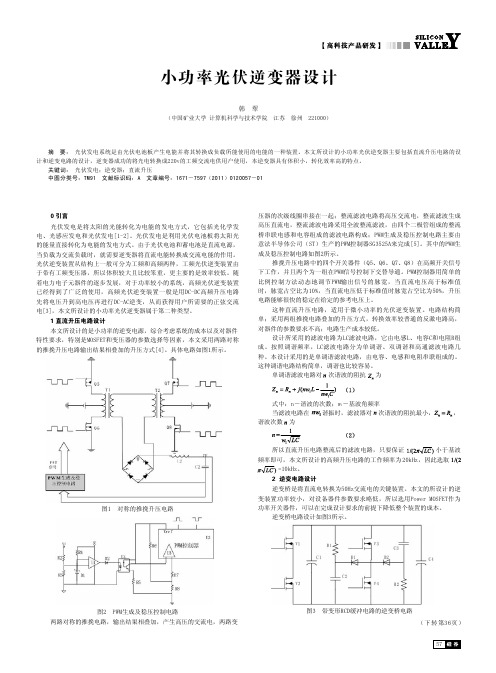
小功率光伏逆变器设计韩 翠(中国矿业大学 计算机科学与技术学院 江苏 徐州 221000)摘 要: 光伏发电系统是由光伏电池板产生电能并将其转换成负载所能使用的电能的一种装置。
本文所设计的小功率光伏逆变器主要包括直流升压电路的设计和逆变电路的设计,逆变器成功的将光电转换成220v 的工频交流电供用户使用,本逆变器具有体积小,转化效率高的特点。
关键词: 光伏发电;逆变器;直流升压中图分类号:TM91 文献标识码:A 文章编号:1671-7597(2011)0120057-010 引言压器的次级线圈串接在一起;整流滤波电路将高压交流电,整流滤波生成高压直流电,整流滤波电路采用全波整流滤波,由四个二极管组成的整流光伏发电是将太阳的光能转化为电能的发电方式,它包括光化学发桥串联电感和电容组成的滤波电路构成;PWM 生成及稳压控制电路主要由电、光感应发电和光伏发电[1-2]。
光伏发电是利用光伏电池板将太阳光意法半导体公司(ST )生产的PWM 控制器SG3525A 来完成[5]。
其中的PWM 生的能量直接转化为电能的发电方式。
由于光伏电池和蓄电池是直流电源,成及稳压控制电路如图2所示。
当负载为交流负载时,就需要逆变器将直流电能转换成交流电能的作用。
推挽升压电路中的四个开关器件(Q5、Q6、Q7、Q8)在高频开关信号光伏逆变装置从结构上一般可分为工频和高频两种,工频光伏逆变装置由下工作,并且两个为一组在PWM 信号控制下交替导通。
PWM 控制器用简单的于带有工频变压器,所以体积较大且比较笨重,更主要的是效率较低。
随比例控制方法动态地调节PWM 输出信号的脉宽,当直流电压高于标准值着电力电子元器件的逐步发展,对于功率较小的系统,高频光伏逆变装置时,脉宽占空比为10%,当直流电压低于标准值时脉宽占空比为50%,升压已经得到了广泛的使用,高频光伏逆变装置一般是用DC-DC 高频升压电路电路能够很快的稳定在给定的参考电压上。
微型光伏逆变器设计要素及拓扑结构
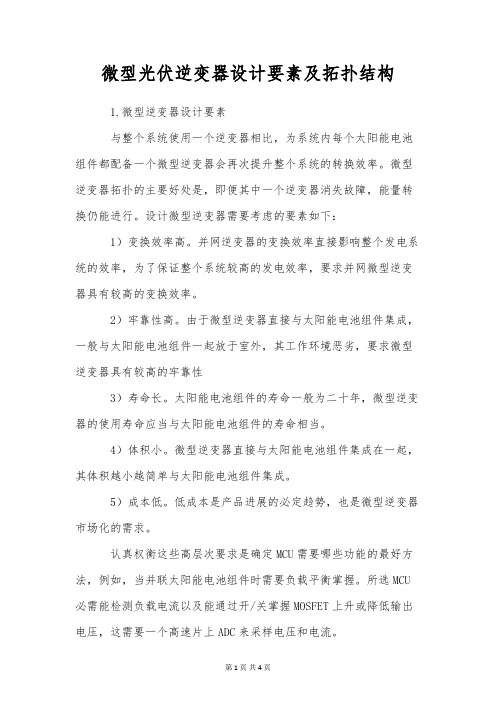
微型光伏逆变器设计要素及拓扑结构1.微型逆变器设计要素与整个系统使用一个逆变器相比,为系统内每个太阳能电池组件都配备一个微型逆变器会再次提升整个系统的转换效率。
微型逆变器拓扑的主要好处是,即便其中一个逆变器消失故障,能量转换仍能进行。
设计微型逆变器需要考虑的要素如下:1)变换效率高。
并网逆变器的变换效率直接影响整个发电系统的效率,为了保证整个系统较高的发电效率,要求并网微型逆变器具有较高的变换效率。
2)牢靠性高。
由于微型逆变器直接与太阳能电池组件集成,一般与太阳能电池组件一起放于室外,其工作环境恶劣,要求微型逆变器具有较高的牢靠性3)寿命长。
太阳能电池组件的寿命一般为二十年,微型逆变器的使用寿命应当与太阳能电池组件的寿命相当。
4)体积小。
微型逆变器直接与太阳能电池组件集成在一起,其体积越小越简单与太阳能电池组件集成。
5)成本低。
低成本是产品进展的必定趋势,也是微型逆变器市场化的需求。
认真权衡这些高层次要求是确定MCU需要哪些功能的最好方法,例如,当并联太阳能电池组件时需要负载平衡掌握。
所选MCU 必需能检测负载电流以及能通过开/关掌握MOSFET上升或降低输出电压,这需要一个高速片上ADC来采样电压和电流。
对于针对光伏逆变器应用所设计的MCU,一个极具价值的特性是双片上振荡器,可用于时钟故障检测以提高牢靠性。
能够同时运行两个系统时钟的力量也有助于削减太阳能电池组件安装时消失的问题。
由于在微型逆变器设计中分散了如此多的创新,对MCU来说,其最重要的特性或许就是软件编程力量,该特性使得在电源电路设计和掌握中拥有最高的敏捷性。
片上集成恰当的掌握外设以及高模拟集成度是保证系统低成本的两个基本要素,为执行针对优化转换、系统监控和能量存储各环节中的效率所开发出的算法,高性能也是必需的。
2.微型逆变器拓扑结构微型逆变器的特别应用需求,打算了其不能采纳传统的降压型逆变器拓扑结构,如全桥、半桥等拓扑,而应当选择能够同时实现升降压变换功能的变换器拓扑,除能够实现升降压变换功能外,还应实现电气隔离;另一方面,高效率、小体积的要求打算了其不能采纳工频变压器实现电气隔离,需要采纳高频变压器。
小型太阳能光伏发电系统设计
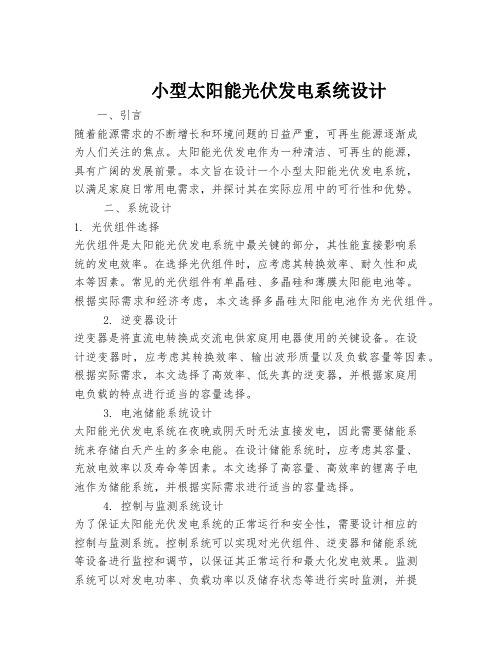
小型太阳能光伏发电系统设计一、引言随着能源需求的不断增长和环境问题的日益严重,可再生能源逐渐成为人们关注的焦点。
太阳能光伏发电作为一种清洁、可再生的能源,具有广阔的发展前景。
本文旨在设计一个小型太阳能光伏发电系统,以满足家庭日常用电需求,并探讨其在实际应用中的可行性和优势。
二、系统设计1. 光伏组件选择光伏组件是太阳能光伏发电系统中最关键的部分,其性能直接影响系统的发电效率。
在选择光伏组件时,应考虑其转换效率、耐久性和成本等因素。
常见的光伏组件有单晶硅、多晶硅和薄膜太阳能电池等。
根据实际需求和经济考虑,本文选择多晶硅太阳能电池作为光伏组件。
2. 逆变器设计逆变器是将直流电转换成交流电供家庭用电器使用的关键设备。
在设计逆变器时,应考虑其转换效率、输出波形质量以及负载容量等因素。
根据实际需求,本文选择了高效率、低失真的逆变器,并根据家庭用电负载的特点进行适当的容量选择。
3. 电池储能系统设计太阳能光伏发电系统在夜晚或阴天时无法直接发电,因此需要储能系统来存储白天产生的多余电能。
在设计储能系统时,应考虑其容量、充放电效率以及寿命等因素。
本文选择了高容量、高效率的锂离子电池作为储能系统,并根据实际需求进行适当的容量选择。
4. 控制与监测系统设计为了保证太阳能光伏发电系统的正常运行和安全性,需要设计相应的控制与监测系统。
控制系统可以实现对光伏组件、逆变器和储能系统等设备进行监控和调节,以保证其正常运行和最大化发电效果。
监测系统可以对发电功率、负载功率以及储存状态等进行实时监测,并提供相应数据供用户参考。
三、性能分析1. 发电效率分析通过对太阳辐射强度和光伏组件转换效率等因素进行分析,可以评估太阳能光伏发电系统的发电效率。
根据实际数据和模拟计算,本文得出了系统的平均发电效率,并与其他可再生能源发电系统进行了比较。
2. 经济性分析太阳能光伏发电系统的经济性是评估其实际应用价值的重要指标。
本文通过对系统的投资成本、运行维护成本和可回收能源价值等进行综合分析,得出了太阳能光伏发电系统在经济上的可行性,并与传统能源供应方式进行了对比。
小型离网光伏发电系统中逆变器的设计与仿真

小型离网光伏发电系统中逆变器的设计与仿真本文针对光伏发电系统中的核心环节-光伏逆变器进行了设计,分析了其拓扑结构与数学模型,其主电路由BOOST升压电路与单相全桥逆变电路组成,控制电路采用TMS320LF2812型DSP作为控制器件,采用PI+复合的控制算法,最后通过MATLAB/SIMULINK仿真验证了设计的合理性。
标签:离网逆变器;光伏阵列;BOOST升压电路;重复控制引言目前,能源紧缺已成为我国乃至整个世界经济发展所面临的一个重要问题,而太阳能由于安全、可靠、环保、可持续利用的特点,越来越多的被人们广泛的开发利用,太阳能光伏发电系统已经成为目前各国研究设计的一个重要内容,本文以小型离网光伏发电系统中的逆变器为研究对象,对其展开设计分析。
1 逆变器的设计1.1 小型离网光伏逆变器结构的设计小型离网光伏发电系统由光伏阵列、蓄电池组、光伏控制器、光伏逆变器、交直流负载等几部分组成,其基本结构如图1所示。
白天,光伏阵列将太阳能转化为电能,在光伏控制器控制下,为交直流负载提供电能,并为蓄电池充电;夜晚,蓄电池储存的电经光伏控制器为交直流负载供电[1]。
其中光伏逆变器将光伏阵列或蓄电池出来的直流电转化为交流电,是整个光伏发电系统的核心设备。
逆变器结构由输入电路、逆变电路、输出滤波电路、控制电路、保护电路和辅助电源等组成,如图2所示。
其中输入电路将光伏阵列或蓄电池出来的直流电整形滤波,小型离网光伏系统的逆变器常采用单相逆变器,逆变电路将直流电转变为单相交流电,如果采用开环控制,输出量不用反馈到控制电路,而如果采用闭环控制,输出量还要反馈到控制电路。
控制电路的功能是按要求产生并调节一系列的控制脉冲来控制逆变开关管的导通和关断,从而配合逆变主电路完成逆变功能。
辅助电源的功能是为控制电路提供直流工作电压。
保护电路主要实现过压保护、欠压保护、过负荷保护、短路保护等。
1.2 小型离网光伏逆变器主电路的设计考虑到采用变压器的逆变电路中变压器的能耗问题,拓扑结构采用了无变压器的逆变电路,其结构如图3所示,由蓄电池或光伏阵列出来的直流电经过直流升压后,再经过逆变滤波,转化为负载可以直接利用的交流电。
光伏发电系统中逆变器方案的设计

光伏发电系统中逆变器方案的设计随着可再生能源的不断发展和应用,光伏发电系统已成为一种重要的清洁能源发电方式。
而光伏发电系统中的逆变器作为转换直流电能为交流电能的关键设备,在系统设计中起着至关重要的作用。
本文将从光伏发电系统逆变器的基本原理、设计要求和技术方案等几个方面展开,探讨光伏发电系统中逆变器方案的设计。
一、光伏发电系统逆变器的基本原理光伏发电系统中的太阳能电池板将太阳能转换成直流电能,而交流电力系统则需求交流电能,因此就须要借助逆变器将光伏发电的直流电能转化为电能输出。
逆变器的作用是通过改变电压、频率和相位,将直流电转换为交流电。
逆变器的工作原理主要包括开关元件的控制和功率电子器件的转换过程。
二、光伏发电系统逆变器的设计要求1.效率高:光伏发电系统逆变器的效率对系统的发电量和经济性影响较大,因此要求逆变器的效率尽可能高。
2.稳定性好:光伏发电系统在日常运行中会受到日照、温度等环境因素的影响,因此逆变器需要具有良好的稳定性,能够适应不同的工作环境。
3.可靠性高:作为光伏发电系统的核心部件之一,逆变器的可靠性对系统的发电效率和稳定性至关重要。
4.通信便捷:逆变器需要实时监测光伏发电系统的工作状态、数据参数等信息,并与其他设备进行通信,以实现对系统的有效监控和管理。
三、光伏发电系统中逆变器的技术方案1. 多级逆变器技术方案:多级逆变器是一种将直流电能分阶段进行逆变的技术方案,能够有效降低开关器件的损耗,提高系统的整体效率。
在光伏发电系统中采用多级逆变器技术方案,可以有效提高系统的功率密度和可靠性,从而实现更好的发电效果。
2. 智能控制技术方案:智能控制技术方案是指通过先进的控制算法和通信技术,实现对逆变器的精准控制和实时监测。
通过智能控制技术,可以对光伏发电系统的运行状态进行精准调节,提高系统的稳定性和效率。
3. 模块化设计技术方案:模块化设计技术方案是指将逆变器设计为多个功能模块组成的结构,可以根据实际需要进行灵活组合和扩展。
一种新型小功率光伏并网逆变器设计
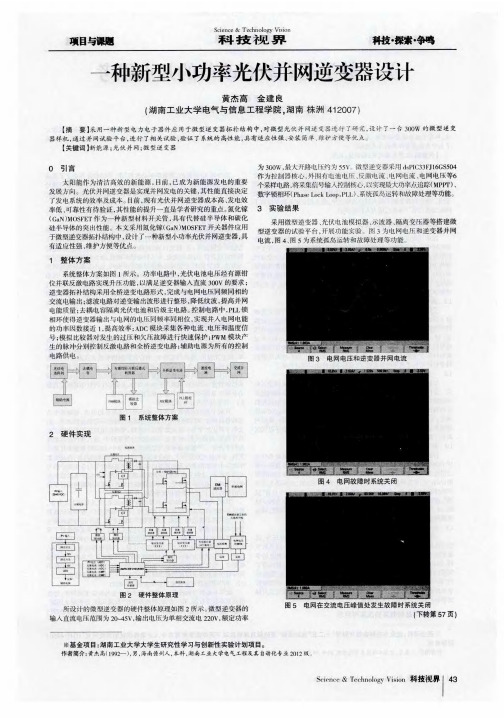
色调应选用 中低彩度 、中高明度的中性色或冷灰色为主的复合色彩 .从 部分应选择 中低明度 、中低彩度的色彩来表现高层建筑的沉稳感 .建筑
而与建筑稳重大气 的风格相协调
顶层部分应选择高明度 、低彩度的色彩来弱化高层建筑的压迫感
3.3.3 商业休闲类建筑推荐色谱
3.4.2 滨 河 沿 线 带
应 有的专业知识 以外 ,更加 注重 教师 自身多元化 解题 能力 的训练 ,认
学会从数学 的角度来 寻找问题 的出发点 ,简化和量 化客观事物 。 可教 师职业素养 的良莠不齐和教学方法的差异化 ,对 寻求对课程 标准
如何完整 、严 密、系统地 思考问题 ,甚至建 立数学模型 的思想 ,合理地 中数学专业知识 的深层理解。
统筹安排等等。当每一个人步人社会后 ,如果他不是从事与数学领域
数学基础教育改革一直都受到多方的关 注。从最初借鉴国外 成功
相关的工作 ,那么他曾经学 习过 的大部分数学定理和公式可能大都用 经验 、吸纳先进改革模式与措施 ,到结 合我国数学基础教育现状 ,从教
形可以得出,所设计的微型逆变器样机可以很好地实现并网发电功 [3]李鸽 .,J、功率光伏并网逆变器的设计【D】l河南:河南理工 大学,2009:
能。e
[4]潘铭航.基于反激拓扑的光伏微型并网逆变器【D】.浙江:浙江大学,2013. [5]王秀荣 饿 型 光伏并 网逆 变器及其 关键技 术研 宄[D】.北 京:北 京交 通大 学
项目与深置
Sc科ience& 技Tech视nology界 Visio n
科技
· 探索·争鸣
3.3.2 商务金融类建筑推荐色谱
高层建筑的墙面适宜采用中高明度 、中低彩度的金属板 、石材和玻璃等
光伏逆变器的设计与控制
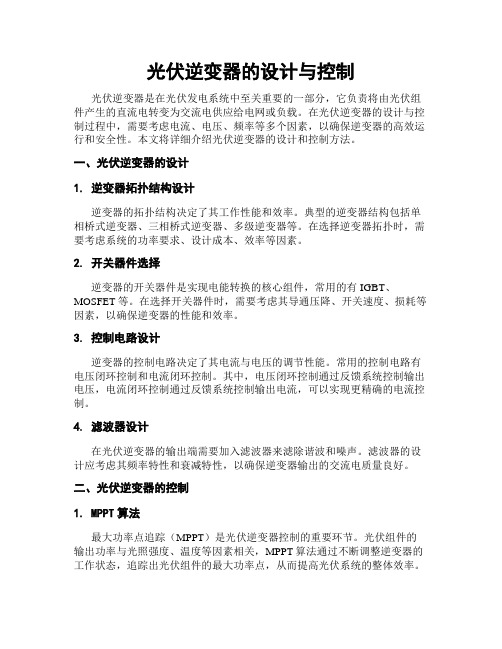
光伏逆变器的设计与控制光伏逆变器是在光伏发电系统中至关重要的一部分,它负责将由光伏组件产生的直流电转变为交流电供应给电网或负载。
在光伏逆变器的设计与控制过程中,需要考虑电流、电压、频率等多个因素,以确保逆变器的高效运行和安全性。
本文将详细介绍光伏逆变器的设计和控制方法。
一、光伏逆变器的设计1. 逆变器拓扑结构设计逆变器的拓扑结构决定了其工作性能和效率。
典型的逆变器结构包括单相桥式逆变器、三相桥式逆变器、多级逆变器等。
在选择逆变器拓扑时,需要考虑系统的功率要求、设计成本、效率等因素。
2. 开关器件选择逆变器的开关器件是实现电能转换的核心组件,常用的有IGBT、MOSFET等。
在选择开关器件时,需要考虑其导通压降、开关速度、损耗等因素,以确保逆变器的性能和效率。
3. 控制电路设计逆变器的控制电路决定了其电流与电压的调节性能。
常用的控制电路有电压闭环控制和电流闭环控制。
其中,电压闭环控制通过反馈系统控制输出电压,电流闭环控制通过反馈系统控制输出电流,可以实现更精确的电流控制。
4. 滤波器设计在光伏逆变器的输出端需要加入滤波器来滤除谐波和噪声。
滤波器的设计应考虑其频率特性和衰减特性,以确保逆变器输出的交流电质量良好。
二、光伏逆变器的控制1. MPPT算法最大功率点追踪(MPPT)是光伏逆变器控制的重要环节。
光伏组件的输出功率与光照强度、温度等因素相关,MPPT算法通过不断调整逆变器的工作状态,追踪出光伏组件的最大功率点,从而提高光伏系统的整体效率。
2. 电网连接控制光伏逆变器通常需要与电网连接,与电网进行同步运行。
在电网连接控制中,需要考虑电压频率、相位等因素,确保逆变器输出的交流电与电网保持同步,并满足电网的电压、频率等要求。
3. 故障保护光伏逆变器的故障保护是确保逆变器安全运行的重要环节。
常见的故障包括过压、过流、短路等,逆变器应具备对这些故障进行检测和保护的能力,同时及时发出警报并停机,以避免损坏设备或危害人身安全。
光伏发电逆变器设计 -回复
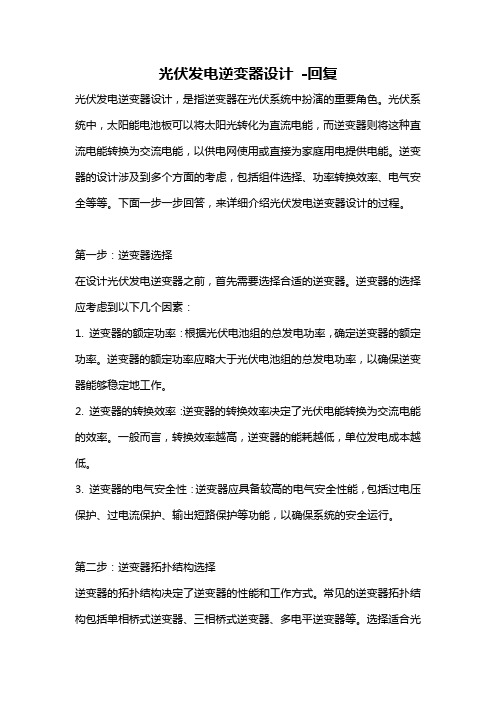
光伏发电逆变器设计-回复光伏发电逆变器设计,是指逆变器在光伏系统中扮演的重要角色。
光伏系统中,太阳能电池板可以将太阳光转化为直流电能,而逆变器则将这种直流电能转换为交流电能,以供电网使用或直接为家庭用电提供电能。
逆变器的设计涉及到多个方面的考虑,包括组件选择、功率转换效率、电气安全等等。
下面一步一步回答,来详细介绍光伏发电逆变器设计的过程。
第一步:逆变器选择在设计光伏发电逆变器之前,首先需要选择合适的逆变器。
逆变器的选择应考虑到以下几个因素:1. 逆变器的额定功率:根据光伏电池组的总发电功率,确定逆变器的额定功率。
逆变器的额定功率应略大于光伏电池组的总发电功率,以确保逆变器能够稳定地工作。
2. 逆变器的转换效率:逆变器的转换效率决定了光伏电能转换为交流电能的效率。
一般而言,转换效率越高,逆变器的能耗越低,单位发电成本越低。
3. 逆变器的电气安全性:逆变器应具备较高的电气安全性能,包括过电压保护、过电流保护、输出短路保护等功能,以确保系统的安全运行。
第二步:逆变器拓扑结构选择逆变器的拓扑结构决定了逆变器的性能和工作方式。
常见的逆变器拓扑结构包括单相桥式逆变器、三相桥式逆变器、多电平逆变器等。
选择适合光伏发电系统的拓扑结构需要考虑到系统的电压、功率因数、谐波失真等指标。
第三步:逆变器控制策略设计逆变器的控制策略直接影响逆变器的性能和稳定性。
常见的逆变器控制策略包括脉宽调制控制策略、电流控制策略等。
通过合理选择控制策略,可以提高逆变器的转换效率,降低谐波失真等。
第四步:逆变器电路设计逆变器的电路设计需要根据选择的拓扑结构和控制策略进行。
电路设计包括电源部分、功率开关部分、驱动电路部分等。
在设计电路时,需要考虑到各个部件的耐压、耐流等参数,并进行合理的电路布局。
第五步:逆变器保护设计逆变器的保护设计是确保逆变器在异常情况下有效保护自身和整个系统的重要环节。
常见的逆变器保护装置包括过流保护、过温保护、过压保护、短路保护等。
小型离网光伏发电系统逆变器的研制

小型离网光伏发电系统逆变器的研制1. 本文概述随着全球对可再生能源的需求不断增长,光伏发电系统作为其中一种重要的能源形式,正受到越来越多的关注。
在众多光伏发电系统中,小型离网光伏发电系统因其安装灵活、维护简便等优点,被广泛应用于偏远地区、户外活动以及紧急电源供应等领域。
小型离网光伏发电系统的核心组件——逆变器,其性能的优劣直接影响到整个系统的效率和稳定性。
本文旨在研制一种高效、稳定的小型离网光伏发电系统逆变器。
通过对现有逆变器技术的深入分析,明确了当前逆变器在小型离网光伏系统中存在的问题和挑战。
接着,本文提出了一种新型的逆变器设计方案,该方案在提升转换效率、降低能耗、增强系统稳定性等方面具有显著优势。
本文的主要内容包括:逆变器的工作原理和关键技术研究、新型逆变器的设计与实现、以及逆变器的性能测试与分析。
通过这些研究,本文不仅为小型离网光伏发电系统提供了一种高效的逆变器解决方案,而且也为逆变器技术的进一步发展提供了新的思路和方向。
2. 文献综述小型离网光伏发电系统作为可再生能源利用的重要组成部分,在全球范围内得到了广泛的关注和发展。
逆变器作为该系统中的核心组件,负责将光伏板产生的直流电转换为交流电,以供家庭或小型社区使用。
随着技术的进步,逆变器的设计和效率成为研究的热点。
过去几年,研究人员在逆变器效率提升方面取得了显著进展。
高效能的半导体材料如硅碳(SiC)和氮化镓(GaN)的使用,显著降低了逆变器的能量损耗。
新型拓扑结构和控制策略也被提出以优化逆变器性能。
离网光伏系统通常安装在偏远地区,因此逆变器的长期稳定运行至关重要。
文献中对于提高逆变器在高温、潮湿等恶劣环境下的可靠性进行了广泛研究,包括热管理技术、故障诊断和预测维护等方面。
随着智能电网的发展,逆变器在电网交互方面的作用日益重要。
研究集中在逆变器的电网支持功能,如频率和电压调节,以及与储能系统的集成。
尽管在逆变器技术上取得了进步,但仍存在一些挑战。
光伏发电系统中逆变器方案的设计
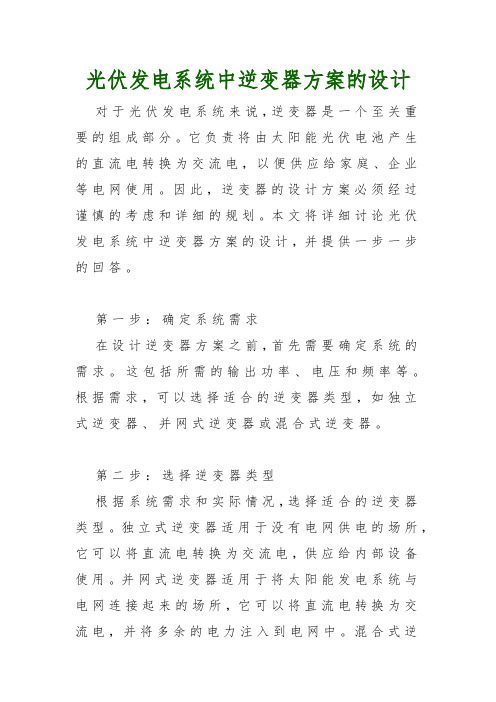
光伏发电系统中逆变器方案的设计对于光伏发电系统来说,逆变器是一个至关重要的组成部分。
它负责将由太阳能光伏电池产生的直流电转换为交流电,以便供应给家庭、企业等电网使用。
因此,逆变器的设计方案必须经过谨慎的考虑和详细的规划。
本文将详细讨论光伏发电系统中逆变器方案的设计,并提供一步一步的回答。
第一步:确定系统需求在设计逆变器方案之前,首先需要确定系统的需求。
这包括所需的输出功率、电压和频率等。
根据需求,可以选择适合的逆变器类型,如独立式逆变器、并网式逆变器或混合式逆变器。
第二步:选择逆变器类型根据系统需求和实际情况,选择适合的逆变器类型。
独立式逆变器适用于没有电网供电的场所,它可以将直流电转换为交流电,供应给内部设备使用。
并网式逆变器适用于将太阳能发电系统与电网连接起来的场所,它可以将直流电转换为交流电,并将多余的电力注入到电网中。
混合式逆变器则是两者的结合,适用于同时具备独立供电和并网供电的场所。
第三步:确定逆变器容量逆变器容量是指逆变器可以承载的最大功率。
根据系统需求和实际情况,确定逆变器的容量。
一般来说,逆变器的容量应略大于系统的峰值功率需求,以确保逆变器可以稳定运行并承载额外的负载。
此外,逆变器的容量还应考虑光伏电池组的数量和输出功率。
第四步:选择逆变器拓扑结构逆变器拓扑结构是指逆变器内部电路的连接方式和电子元件的布局。
常见的逆变器拓扑结构有单相桥式逆变器、三相桥式逆变器和多级逆变器等。
选择逆变器拓扑结构时,需要考虑功率密度、效率、可靠性等因素。
第五步:设计逆变器控制策略逆变器的控制策略决定了其工作方式和性能。
常见的逆变器控制策略包括脉宽调制(P W M)控制、电流控制和电压控制等。
选择适合的控制策略时,需要考虑输出电压的稳定性、谐波失真等因素。
第六步:选择逆变器的电子元件逆变器的电子元件包括功率开关器件、驱动电路、滤波电路等。
选择适合的电子元件时,需要考虑功率损耗、效率、成本等因素。
第七步:优化散热设计逆变器在工作过程中会产生大量的热量,因此散热设计是非常关键的。
小型独立光伏发电系统逆变器的设计【开题报告】

毕业设计开题报告电气工程及其自动化小型独立光伏发电系统逆变器的设计1选题的背景、意义进入2 1世纪,能源问题成为全世界共同关注的十大焦点问题之首。
太阳能是绿色无污染的新能源,太阳能光伏发电系统是利用太阳电池半导体材料的光伏效应,将太阳光辐射能直接转换为电能的一种新型发电系统。
它一方面节约了大量的煤炭等不可再生能源,另一方面由于不产生任何污染,减少了对环境再处理的大量资金投入。
目前,世界上很多发达国家对在城市大规模建设并网光伏系统都非常重视。
太阳能开发发利用技术发展很快,特别是70年代爆发的世界性的石油危机有力地促进了太阳能的开发与利用。
经过近半个世纪的努力,太阳能光热利用技术及其产业异军突起,成为能源工业的一支生力军。
利用太阳能的方式很多,主要有“太阳能发电”、“太阳能热利用”、“太阳能动力利用”、“太阳能光化利用”、“太阳能生物利用”和“太阳能光一光利用”等。
由于电能是现代工业中最常用的直接能源,因此由太阳能直接转化成电能是太阳能利用中的最具有前景的方式,而太阳能光伏发电是最重要的形式[1]。
我国“十五”期间成功实施的“光明工程"、“屋顶光伏示范工程"等项目,为我国光伏发电技术的推广应用奠定了良好的基础。
我国已经把开发利用光伏发电等可再生能源作为发展的优先领域,最近国家发改委公布了我国可再生能源中长期规划:至2010年我国光伏发电总装机容量累计目标为400MW;至2020年,全国可再生能源开发利用总量在能源供应结构中的比重目标提高到15%左右,其中光伏发电将占有较大的比重。
目前,我国北京、上海、深圳等地相继推出了光伏建筑一体化并网发电示范工程,为我国光伏发电系统的推广应用创造了良好的市场前景,可见,未来我国光伏产业将得到高速发展[3]。
在光伏发电中,逆变器是至关重要的一个组成部分。
太阳能逆变器可分为三种型式:离线型或称之为独立型,此种逆变器由电池供电,产生方波或正弦波型式的交流输出,提供独立系统的用电,但无法与市电并联。
光伏逆变器的设计与调试

光伏逆变器的设计与调试光伏逆变器是太阳能发电系统中的一个重要组成部分,起着将直流电转化为交流电的作用。
因此,光伏逆变器的设计和调试非常关键,直接影响系统的性能和效率。
本文就光伏逆变器的设计和调试进行探讨。
一、光伏逆变器的组成光伏逆变器主要由直流输入、逆变器单元、输出滤波和控制电路四个部分组成。
其中,直流输入部分由光伏电池板、充电控制器等组成,逆变器单元则是将直流电信号转变为交流电信号,输出滤波部分则是对逆变器输出的交流电进行滤波处理,防止其产生干扰信号,最后,控制电路则是该系统的大脑,负责光伏逆变器的运行控制。
二、光伏逆变器的设计1. 选型与布局在设计光伏逆变器时,首先需要选取适合的元器件。
逆变器单元中的IGBT模块和变压器等组件都需要具备可靠性高、温度范围广、输出电流大等特点。
在元器件选型完成后,需要进行适当的布局。
尤其是IGBT模块因发热量较大,需要做好散热设计。
2. PCB设计PCB电路板是光伏逆变器中一个非常重要的部分,决定了系统信号传输的质量和速度。
在PCB设计中,需要注意如下几点:- 尽量缩短信号传输的路径;- 将信号传输线与电源线、散热器之间隔离开;- 在PCB布线时,给出了适当的过度,使信号尽可能平滑过渡;- 在布线时尽量避免信号串扰。
3. 控制算法设计光伏逆变器控制算法主要分为闭环控制和开环控制两种,并且在实际应用中,一般采用两者同时使用。
闭环控制一般用于调节系统输出电压、电流、功率等参数,而开环控制则是用于调节系统的稳定性和响应速度。
在控制算法设计中,需要注意如下几点:- 设计闭环控制器参数时,应结合逆变器的动态响应和负载特性;- 算法复杂度要尽可能的低,并且能够实现实时响应;- 为提高算法可靠性,应采用恰当的PID控制策略。
三、光伏逆变器的调试光伏逆变器在设计完成后,需要进行适当的调试,保证其正常运行。
在光伏逆变器调试过程中,需要注意如下几点:- 逆变器单元的调试要注意控制算法的参数设置,同时根据系统输出电压和电流的变化情况,进行相应的调整;- 在调试过程中,要根据逆变器输出信号的波形,进行相应的正反接线检查;- 手动切换逆变器开关,验证逆变器的输出功率是否正常;- 在调试过程中,需要对逆变器输出的电压、电流、频率等参数进行实时监测,保证系统的正常工作。
离网型小功率光伏发电逆变器设计
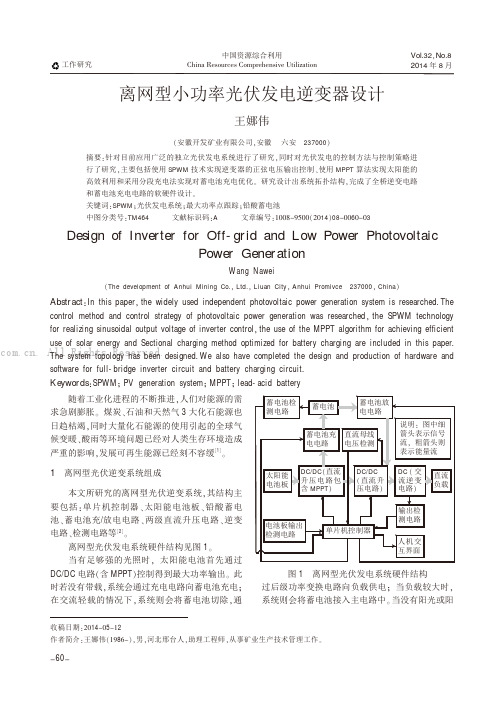
●随着工业化进程的不断推进,人们对能源的需求急剧膨胀。
煤炭、石油和天然气3大化石能源也日趋枯竭,同时大量化石能源的使用引起的全球气候变暖、酸雨等环境问题已经对人类生存环境造成严重的影响,发展可再生能源已经刻不容缓[1]。
1离网型光伏逆变系统组成本文所研究的离网型光伏逆变系统,其结构主要包括:单片机控制器、太阳能电池板、铅酸蓄电池、蓄电池充/放电电路、两级直流升压电路、逆变电路、检测电路等[2]。
离网型光伏发电系统硬件结构见图1。
当有足够强的光照时,太阳能电池首先通过DC/DC 电路(含MPPT )控制得到最大功率输出。
此时若没有带载,系统会通过充电电路向蓄电池充电;在交流轻载的情况下,系统则会将蓄电池切除,通图1离网型光伏发电系统硬件结构过后级功率变换电路向负载供电;当负载较大时,系统则会将蓄电池接入主电路中。
当没有阳光或阳Vol.32,No.82014年8月中国资源综合利用China Resources Comprehensive Utilization离网型小功率光伏发电逆变器设计王娜伟(安徽开发矿业有限公司,安徽六安237000)摘要:针对目前应用广泛的独立光伏发电系统进行了研究,同时对光伏发电的控制方法与控制策略进行了研究,主要包括使用SPWM 技术实现逆变器的正弦电压输出控制、使用MPPT 算法实现太阳能的高效利用和采用分段充电法实现对蓄电池充电优化。
研究设计出系统拓扑结构,完成了全桥逆变电路和蓄电池充电电路的软硬件设计。
关键词:SPWM ;光伏发电系统;最大功率点跟踪;铅酸蓄电池中图分类号:TM464文献标识码:A文章编号:1008-9500(2014)08-0060-03Design of Inverter for Off-grid and Low Power PhotovoltaicPower GenerationWang Nawei(The development of Anhui Mining Co.,Ltd.,Liuan City ,Anhui Promivce237000,China )Abstract :In this paper ,the widely used independent photovoltaic power generation system is researched.Thecontrol method and control strategy of photovoltaic power generation was researched ,the SPWM technologyfor realizing sinusoidal output voltage of inverter control ,the use of the MPPT algorithm for achieving efficientuse of solar energy and Sectional charging method optimized for battery charging are included in this paper.The system topology has been designed.Wealso have completed the design and production of hardware andsoftware for full-bridge inverter circuit and battery charging circuit.Keywords :SPWM ;PV generation system ;MPPT ;lead-acid battery收稿日期:2014-05-12作者简介:王娜伟(1986-),男,河北邢台人,助理工程师,从事矿业生产技术管理工作。
光伏并网微逆变器的设计
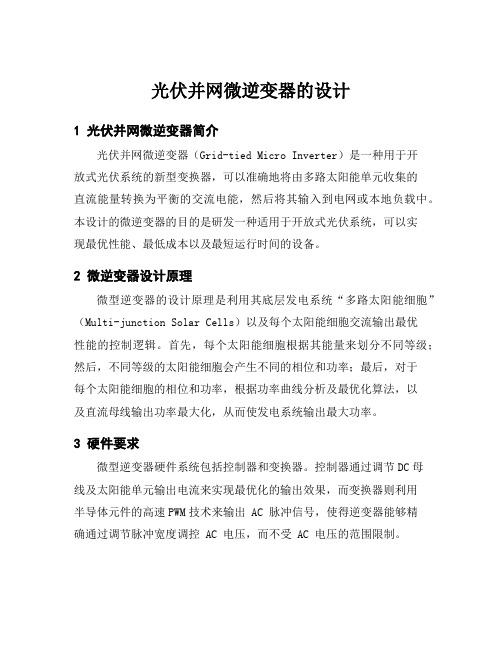
光伏并网微逆变器的设计
1 光伏并网微逆变器简介
光伏并网微逆变器(Grid-tied Micro Inverter)是一种用于开
放式光伏系统的新型变换器,可以准确地将由多路太阳能单元收集的
直流能量转换为平衡的交流电能,然后将其输入到电网或本地负载中。
本设计的微逆变器的目的是研发一种适用于开放式光伏系统,可以实
现最优性能、最低成本以及最短运行时间的设备。
2 微逆变器设计原理
微型逆变器的设计原理是利用其底层发电系统“多路太阳能细胞”(Multi-junction Solar Cells)以及每个太阳能细胞交流输出最优
性能的控制逻辑。
首先,每个太阳能细胞根据其能量来划分不同等级;然后,不同等级的太阳能细胞会产生不同的相位和功率;最后,对于
每个太阳能细胞的相位和功率,根据功率曲线分析及最优化算法,以
及直流母线输出功率最大化,从而使发电系统输出最大功率。
3 硬件要求
微型逆变器硬件系统包括控制器和变换器。
控制器通过调节DC母
线及太阳能单元输出电流来实现最优化的输出效果,而变换器则利用
半导体元件的高速PWM技术来输出 AC 脉冲信号,使得逆变器能够精
确通过调节脉冲宽度调控 AC 电压,而不受 AC 电压的范围限制。
4 其他考虑因素
在微逆变器的设计中,除了硬件设计外,还必须考虑应用场景周围环境因素,比如温度等,否则可能会对设备造成严重损害。
此外,对微型逆变器的设计还需要考虑其安全性问题,即放电防护及湿度防护等,确保微逆变器的安全工作。
5 结论
由于光伏并网微逆变器能够极大提高开放式光伏系统的性能以及效率,因此本设计的微型逆变器将成为未来光伏系统中不可或缺的组成部分。
并网光伏微型逆变器设计

并⽹光伏微型逆变器设计并⽹光伏微型逆变器设计本应⽤参考设计简略描述了单级并⽹太阳能(PV)微型逆变器主要原理。
本设计主要使⽤了⼀颗ST公司的STM32F4系列处理器,该处理器是基于ARM1Cortex?-M4内核具有浮点运算,168MHZ的⾼速处理能⼒,增强的单周期DSP处理指令。
可以进⾏⼀些复杂的计算。
控制PV电池板流向电⽹的功率。
此处理器还执⾏MPPT算法、故障控制,以及可选的数字通信程序。
⽽前级使⽤了宽范围输⼊的反激DC-DC来产⽣与电⽹同相和同步的正弦输出电压和电流。
此微型逆变器的设计⽬标是可连接到这样的PV模块:在22VDC⾄50VDC的输⼊电压范围内,可输出最⼤200W的功率,最⼤开路电压为55VDC。
本设计的要求如下所列:▲最⼤输出功率 = 185W▲标称输出电压 = 230V▲标称输出电流 = 0.8A▲输出电压范围 = 180 VAC - 264 VAC▲标称输出频率 = 50 Hz▲输出频率范围 = 48 Hz- 5 2 Hz▲功率因数 = >0.9 6▲总谐波失真 = <5%▲最⼤效率 = 96 %▲最⼤功率点追踪 = 99.5%▲最⼩效率>0.8并⽹光伏微型逆变器参考设计的框图如图1 所⽰。
本系统主要分7⼤块,PV组件、辅助电源、光伏微型逆变器、EIM滤波、STM32F4、LCD显⽰与键盘。
这⾥最主要的是,光伏微型逆变器和STM32F4所以本应⽤设计主要对这两块做主要介绍。
光伏微型逆变器硬件架构光伏微型逆变器,如图1所⽰主要分两⼤块,前⾯是DC/DC升压及MPPT后⾯是DC/AC桥式换向。
微逆变器电路⼯作原理:把半波的直流电压通过四个可控硅进⾏换向,变成了上下波的交流电压。
通常专⽤术语把此半波称为馒头波,如图2微逆变的⼯作原理波形变换图:由交错反激构成的微逆变器硬件框图,如图3:微逆变器的主要原理:如图3主要有两块组成,交错反激电路和桥式换向电路。
交错反激电路主要功能:如图3虚线框内,来⾃PV的低压直流电,经交错反激电路升压到最⾼400V左右的峰值电压,然后在电容上形成具有正弦特性的直流半波电压。
小功率光伏并网逆变电源的设计

目录摘要...................................... 错误!未定义书签。
ABSTRACT .................................. 错误!未定义书签。
第一章绪论 (1)1.1课题的研究背景与意义 (1)1.2光伏并网发电系统简介 (1)1.3光伏并网发电系统对逆变器的要求 (2)1.4本文的主要研究内容 (2)第二章并网逆变器的设计及系统的工作原理 (3)2.1并网逆变器的选择 (3)2.1.1并网逆变器结构的选择 (3)2.1.2并网逆变器回路方式的选择 (3)2.1.3系统的总体方案 (4)2.2光伏并网发电系统的工作原理 (5)2.2.1前级电路的工作原理 (5)2.2.2后级电路的工作原理 (6)第三章光伏并网发电系统的设计 (7)3.1主电路的设计 (7)3.2控制电路及保护电路的设计 (8)3.2.2并网同步的实现 (8)3.2.3SPWM波的产生 (10)3.2.4保护电路 (11)3.3驱动电路 (11)3.4输出滤波电路 (12)3.5辅助电源设计 (13)3.5.1辅助电源的设计要求 (13)3.5.2辅助电源设计电路 (13)3.6系统的电磁兼容设计 (14)3.6.1硬件方面考虑 (14)3.6.2软件方面考虑 (15)3.7光伏并网逆变器的仿真建模 (15)3.8控制系统软件设计 (16)第四章光伏并网发电系统的孤岛效应及防止策略 (17)4.1孤岛效应及其危害 (17)4.2孤岛效应的检测方法 (17)4.2.1被动检测方法 (17)4.2.2主动检测方法 (18)4.2.3外部检测方法 (18)4.2.4本论文采用的孤岛检测的方法 (19)第五章总结与展望 (21)5.1总结 (21)5.2展望 (21)参考文献 (22)致谢 (36)第一章绪论1.1课题的研究背景与意义世界范围内的能源短缺和环境污染已成为制约人类社会可持续发展的两大重要因素,大力发展新的可替代能源已成为当务之急。
小型独立光伏发电系统逆变器的设计【文献综述】

毕业设计开题报告电气工程及其自动化小型独立光伏发电系统逆变器的设计1前言部分能源是人类社会生存和发展的物质基础,在过去的200多年中,建立在煤、石油、天然气等化石燃料基础上的能源体系极大的推动了人类社会的发展。
然而,人们在物质和精神生活不断提高的同时,也意识到大规模使用这些化石燃料所带来的严重后果,资源日益枯竭,环境不断恶化,这些问题已经展现在人们的面前[1]。
由于常规能源的有限性和分布的不均匀性,造成了世界上大部分国家能源供应不足,不能满足其经济发展的需要,一次能源面临枯竭的危机是大力发展太阳能发电的主要原因之一。
据有关资料显示,按照目前能源的消耗速度,世界一次能源最多只能再用200年左右[2]。
而传统获得电能的主要方式需燃烧大量煤炭、石油等石化材料。
随着现代社会发展对能源需求的不断增加,可供利用的煤炭、石油等一次能源日益枯竭,如不尽早寻求新的替代能源,人类迟早将面临化石燃料枯竭的危机局面。
而新能源如太阳能、风能、潮汐能等可再生能源在全球范围的发展让人们在能源危机的焦虑中,得到不少慰藉[3-4]。
当前,由于燃烧煤、石油等化石燃料,每年有数十万吨含硫化合物物质抛向天空,使大气环境遭到严重污染,直接影响居民的身体健康和生活质量;局部地区形成酸雨,严重污染水土。
我国是世界上最大的煤炭生产国和消费国,仅燃煤产生的SO2就占了全国排放总量的25%,有48个城市的S02超过国家二级排放标准,有82个城市出现过酸雨,超过国土面积40%,其中仅1998年酸雨沉降造成的经济损失就约GNP(国民生产总值)的2%。
由于污染造成经济损失,2004年全国环境污染造成经济损失占当年GDP的3.05%,超过5000亿。
室外空气和水污染对于中国经济造成的健康和非健康损失的总和每年1000亿美元(约相当于中国GDP的5.8%),因此需要大力提高可再生能源在能源消费中的比重。
而化石燃料产生另一大环境问题是“温室效应”,由于化石燃料燃烧排放大量的温室气体CO2而产生温室效应,引起全球气候变化[5-7]。
微型光伏并网逆变器设计

微型光伏并网逆变器设计摘要随着社会的发展,人类社会对能源的需求越来越大。
传统的化石能源日渐枯竭,寻找新能源被世界各国提上议程。
太阳能以其分布广泛、清洁、无污染、取之不尽、用之不竭等优点,引起各国政府的重视。
本文对小功率并网系统进行了深入研究,对一套微型光伏并网逆变器进行了仿真研究。
关键词:微型光伏并网逆变器;两级式1微逆变器的特点微逆变器具有以下优点,更易满足光伏并网发电系统尤其是光伏建筑一体化的技术要求并提高性能:1)有助于提高系统可靠性。
光伏组件串并联组合使用时,存在组件匹配、热斑等问题。
任一组件损坏,将影响系统工作,甚至中断输出;2)发电效率更高。
单个逆变模块对应单块光伏组件,逆变模块具有MPPT功能,则每块光伏组件的能量都能得到最大程度利用;3)降低系统成本。
尽管单个变换器相对成本较高,但其节省长距离直流输配电电缆和大容量交流配电装置,并可安装在室外无需装配机房,减少建设成本。
2 前级升压电路的选择全桥变换器的主要特点有:初级方波电压幅值为±,而非半桥变换器的±,但是其开关管的耐压也等于直流输入电压。
因此当开关管的峰值电压和电压相同时,全桥变换器的输出功率是半桥变换器的两倍。
当在输入功率和输出功率相同的情况下,全桥变换器的初级电流有效值和峰值均为半桥变换器的一半。
图2 全桥电路3 后级逆变电路的选择当采用PWM控制时,半桥电路在输入端只产生两种电平,因此在输出端生成双极性的SPWM波,其幅值是直流电压的一半,直流电压利用率低。
全桥逆变器的直流电压利用率较高,且可以工作于单极性方式,可以减小开关损耗,有利于提高效率。
本文设计的并网逆变器采用全桥逆变器。
图3 本文采用的主电路拓扑4 电流滞环控制电流滞环控制系统的外环采用直流电压环,用来稳定直流母线电压,内环是电流环,用来对电流进行快速跟踪。
外环将逆变器输出参考电流的幅值和与电网电压同步的单位正弦信号相乘,得到逆变器输出参考电流的瞬时值,将与网侧检测电流的差值经滞环比较器处理后,得到控制开关管的PWM波。
- 1、下载文档前请自行甄别文档内容的完整性,平台不提供额外的编辑、内容补充、找答案等附加服务。
- 2、"仅部分预览"的文档,不可在线预览部分如存在完整性等问题,可反馈申请退款(可完整预览的文档不适用该条件!)。
- 3、如文档侵犯您的权益,请联系客服反馈,我们会尽快为您处理(人工客服工作时间:9:00-18:30)。
微型光伏发电逆变器的设计摘要目前,人类社会发展迅速,对能源的需求不断加大,能源危机和环境保护成了21世纪的主题。
太阳能具有无限性,清洁性等特点,如果能加以利用,对人类以后的发展和延续由很重要的意义。
在此背景下,本设计基于TMS320F240对光伏发电并网逆变器做出了分析和研究。
本设计首先介绍了国内外光伏发电的现状,分析了光伏发电的工作原理,然后对主电路结构进行分析和选择,最终确定前级采用Boost升压电路以及后级采用全桥逆变电路,逆变主电路采用无变压器绝缘的两级拓扑结构。
控制方法采用滞环反馈调节。
分析了太阳能电池的工作原理,确定了采用扰动观测法实现最大功率点跟踪(MPPT)的方法。
接着论述了孤岛效应的产生原因和危害,确定了采用周期性扰动正反馈频率漂移(AFDPF)孤岛检测方法。
对系统进行了软硬件的设计,最后利用MATLAB软件对系统部分指标进行了仿真,满足了部分要求。
本次设计能够部分解决地区供电难,社会能源短缺问题,对社会发展和稳定有重大现实意义。
关键词:太阳能,光伏并网逆变器,最大功率点跟踪,孤岛检测,MATLABThe Design of Photovoltaic InverterABSTRACTAt present, the development of human beings growing demand for energy, the energy crisis and environmental pollution have become the theme of this century. In this background, this paper use the solar energy, based on TMS320F240 is designed 800 w miniature grid-connected photovoltaic inverter.At first, this paper analyzes the main circuit structure of system, before the final level using the Boost booster circuit, and the latter adopts full bridge inverter circuit working principle of inverter main circuit adopts the two levels of topological structure of transformer insulation. Then analyzed the working principle of solar cells, determines the disturbance observation method is used to achieve maximum power point tracking (MPPT) method. Then discusses the causes and harm of islanding, determines the periodic disturbance using positive feedback frequency drift island (AFDPF) detection method.Finally, the system hardware and software design, and on the part of the performance of the MATLAB simulation, to verify the part of the performance of the system.KEY WORDS:The solar energy,Photovoltaic grid-connected inverter,Maximum power point tracing,Island detection,MATLAB目录前言 (1)第1章绪论 (2)1.1 微型光伏发电逆变器国内外研究动态 (2)1.2 选题的依据和意义 (2)1.3 基本内容和解决重点问题 (3)1.4 研究进度 (3)1.5 主要内容 (3)第2章控制系统总体设计 (4)2.1 光伏逆变系统的工作过程 (5)2.2 光伏并网逆变系统的性能指标和参数要求 (6)2.2.1 逆变器性能指标 (6)2.2.2 逆变器参数要求 (6)2.3 光伏并网逆变系统的控制方案 (7)2.3.1 系统的整体控制方案 (7)第3章控制系统硬件设计 (10)3.1 控制系统的整体构成 (10)3.2 控制系统中变量分析 (10)3.2.1 变步长扰动观察法实现最大功率点跟踪 (10)3.2.2 孤岛效应及其检测方法 (12)3.3控制系统中所用硬件设备的选择 (13)3.3.1 Boost电路设计 (13)3.3.2 逆变电路设计 (15)3.3.3 驱动电路的设计 (17)3.3.4 控制电路的设计 (18)第4章控制系统的软件设计 (19)4.1 MATLAB简介 (19)4.2控制系统整体设计 (20)4.3 DSP 锁相环节软件设计 (20)第5章系统仿真 (22)5.1电流跟踪型逆变器仿真 (22)5.2光伏阵列的仿真 (25)5.3扰动观察法模型仿真 (28)第6章总结与展望 (31)6.1本设计主要完成的工作 (31)6.2控制系统的性能和优缺点 (31)6.3控制系统设计过程中的技术难点 (32)6.4控制系统还需改进的地方 (32)谢辞 (33)参考文献 (34)外文翻译资料 (36)前言本课题主要针对目前能源问题而设计,能源问题一直关乎人类生存和发展,是人类能否延续下去的关键。
目前资源短缺使得人类必须找到一种新的能源来替代,同时环境污染也是重大问题。
然而太阳能是最好的选择,其一清洁,其二取之不尽用之不竭。
如果能对其加以改造和利用,必然对人类的发展起着至关重要的作用[1]。
从20世纪80年代起中国开始研究了光伏逆变器,现有特定的公司生产光伏发电逆变器。
我国光伏发电逆变器厂商普遍启动时间晚,所以在规模、结构、工艺、做工、性能稳定性国外企业无法相提并论。
不过国内龙头企业合肥阳光电源公司发展迅速,在欧洲市场及国外其他大功率市场取得相当大的成绩。
本次设计分析微型光伏发电及并网工艺过程,主电路主要采用两级电路,前级是Boost升压电路,后级为逆变电路。
主要控制方式是滞环反馈控制,采用变步长最大功率点跟踪方法实现太阳能光伏阵列最大功率电跟踪。
最后在MATLAB中构建了系统的仿真模型,验证了部分系统性能[2]。
第1章绪论1.1 微型光伏发电逆变器国内外研究动态近年来,欧美各国如德国、美国、意大利以及中国光伏产业不断发展,光伏逆变器在全球的销量与日俱争。
欧洲市场得天独厚,成熟的技术使他们具有领先水平,走在世界的前沿。
全球光伏市场日渐兴起,欧洲大多数光伏逆变器厂家开始扩张。
具有先进半导体技术和工业基础的美国和日本在电路设计、自控设计设计方面颇具实力,他们依靠各自的品牌于光伏逆变器生产设计领域拥有很强的实力与优势。
国外主要逆变器厂商有:SMA、KACO、Fronius、Siemens、studer、Danfoss、Spwtick 等公司,其中SMA、KACO、Fronius、Siemens市场占有率达70%,领军国家德国SMA2009年市场销售额占为44%。
这使得传统厂商不得不开始扩充产能,不断扩展渠道,传统电气控制、自动控制控等工业巨头逐渐开始进入新能源市场。
从20世纪80年代起中国开始研究了光伏逆变器,现有特定的公司生产光伏发电逆变器。
我国光伏发电逆变器厂商普遍启动时间晚,所以在规模、结构、工艺、做工、性能稳定性国外企业无法相提并论。
不过国内龙头企业合肥阳光电源公司发展迅速,在欧洲市场及国外其他大功率市场取得相当大的成绩。
如今,虽然国内逆变器生产厂商比较多,但对于光伏发电逆变器的研究的厂家却寥寥无几。
合肥阳光电源股份有限公司、南京冠亚电源设备有限公司等企业的光伏逆变器技术不断上升,产量不断提高,甚至成功研发了大型光伏逆变器。
逆变器的利率可高达35%--40%,主要因为逆变器成本低、技术成熟、供应商少。
以后投资者的不断增加和大规模光伏系统电站的建立必然使得毛利率下降。
“金太阳工程”在一定程度上激励国内商家的发展,给未来光伏器发展带来机遇与挑战[3]。
1.2 选题的依据和意义21世纪是能源危机的时代,能源问题是人类能否延续下去的关键。
目前资源短缺使人类必须找到一种新的能源来替代,同时环境污染也是重大问题。
然而太阳能是最好的选择,其一清洁,其二取之不尽用之不竭。
如果能对其加以改造和利用,必然对人类的发展起着至关重要的作用。
本设计对光伏发电逆变器的总体控制方案、主电路结构、器件选型、光伏太阳能电池的最大功率点跟踪以及孤岛检测进行了深入研究。
1.3 基本内容和解决重点问题本设计基于TMS320F240实现电路控制,主电路采用无变压器绝缘的两级结构,并且有最大功率检测与跟踪以及孤岛效应检测,研究分析了光伏发电并网逆变器,最终输出与电网电压同频同相的正弦电流输出。
(1)分析微型光伏发电及并网工艺过程;(2)在分析工艺过程的基础上,设计系统整体控制方案,选择控制策略;(3)进行硬件电路设计,完成元器件参数计算和选型;(4)硬件电路仿真;(5)搭建硬件电路;(6)电路测试及调整。
1.4 研究进度1-3周:查找相关资料,设计整体方案,撰写开题报告。
4-5周:控制方案设计,元器件参数计算和选型。
6-8周:硬件电路的搭建、仿真和测试。
9-10周:系统控制软件的设计及测试。
11-12周:撰写毕业论文,答辩。
1.5 主要内容本文主要内容分为六个部分:一、绪论,介绍了本设计的来源和意义,概述了光伏发电的工作原理以及光伏逆变的关键技术。
二、研究了并设计出了本系统的主电路结构——无变压器绝缘两级结构,分析了逆变电路。
三、介绍了系统各个关键部分:升压单元、逆变单元、滤波单元、驱动单元、控制单元等器件选型。
四、介绍了系统的软件设计。
五、给出本设计的光伏并网逆变器的仿真来验证部分性能。
六、主要对本次设计的性能指标做出了总结,说明了系统的优缺点以及需要改进的地方。
第2章控制系统总体设计2.1 光伏逆变系统的工作过程白昼,光伏电池组受到太阳光的照射,产生电动势,光伏阵列由数个太阳能电池模块串联形成,它产生的电压应与系统所需要的输入电压相同。
光伏系统主要分为两类:并网系统和独立系统,并网系统就是要与电网连接,则太阳能产生的电流要接入电网;独立系统则不与电网相连接,单独将太阳能产生的电流供给用电设备。
